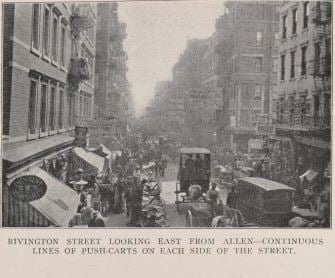Blog Archive
When Life Gives You Lemons, Sell them On the Lower East Side
A pushcart story
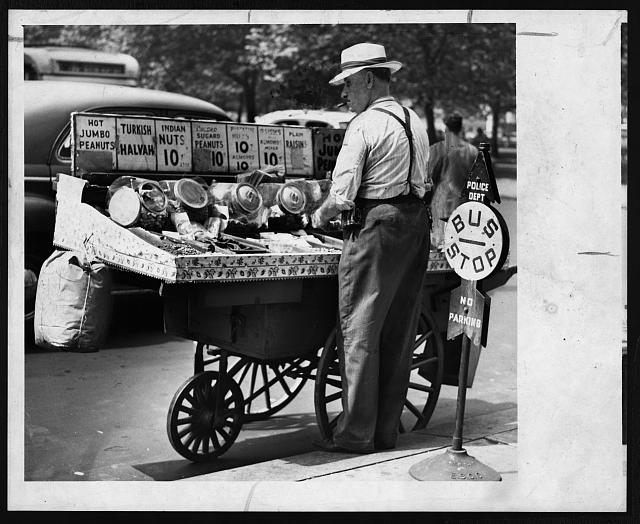
A pushcart vendor selling nuts in New York in 1947. Nut vendors are still one of the most ubiquitous examples of modern pushcarts. Photo courtesy of the Library of Congress.
The immigrants to the Lower East Side at the turn of the Twentieth century brought what skills they could to their new lives in New York but often lacked the opportunity to put these skills to use. Many immigrants were fleeing economic hardship and some immigrants, especially the Jewish populations from Eastern Europe also fled government-sanctioned religious persecution which limited their trades and occupations. Even those exceptions, immigrants who had held higher status jobs at home, mostly lost their standing in their move to the United States.
However there was one job that was open to all, regardless of prior experience or education; immigrants of all social standing found opportunities for work as pushcart vendors. The area with the most replete with push-cart peddlers was the Lower East Side.
These vendors often sold goods to their own neighbors with the benefit of knowing their religious, cultural and practical needs. For decades a vast pushcart economy met the needs of this crowded neighborhood. Pushcart vendors sold everything the residents required from books and toys to clothing and food. Because a majority of Lower East Side residents worked long hours in the garment industry, the pushcart vendors adjusted to this schedule, setting up lanterns and, later electric lights, to allow residents to shop after work. In fact, shopping became a great excuse for young adults in the community to stroll and socialize.
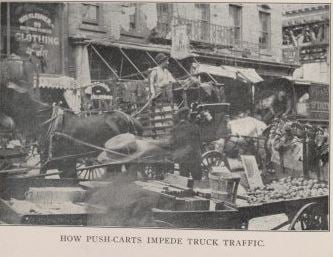
This photo taken in 1906 under the direction of Lawrence Veiller accompanied the report on the "Pushcart Problem." Photo courtesy of the New York Public Library.
In 1899 the price of a municipal pushcart license fell from $15 to $4 and by 1904 there were 6,747 push-cart peddlers in New York City. (Today a food cart vendor license is $200 for a “processing food unit” and $75 for a “non-processing food unit.”) The trade developed so dramatically that the Mayor, George B. McClellan, created a “Commission Appointed to Investigate the Push-Cart Problem.” Pushcarts were partly problematized when, as the report puts it, “traffic regulation [had] arisen.” The narrow streets were choked with carts which proved difficult for carriages and pedestrians to avoid and impossible for automobiles to maneuver around.
The commission supposedly reported that when “the list of goods sold [from the pushcarts] was complete we felt it would probably have been easier to make a list of things that were not sold.” (Quoted in Nan Enstad’s Ladies of Leisure, Girls of Adventure.) The Commission also noted that although no neighborhood in the city was completely free of push-carts “the greatest congestion exist in the most crowded quarters of the Lower East Side especially in the Hebrew quarter.” The report specifies “ that in the section south of Houston street, from the Bowery to the East river, the streets are almost invariably found lined with push-carts on every block; especially on the following streets: Rivington, Grand, Hester, Stanton, Houston, Canal, Monroe, Forsyth, Orchard, Ludlow, Norfolk, Suffolk, Ridge and Pitt.”Our historic tenement at 97 Orchard Street was smack in the middle of the pushcart problem!
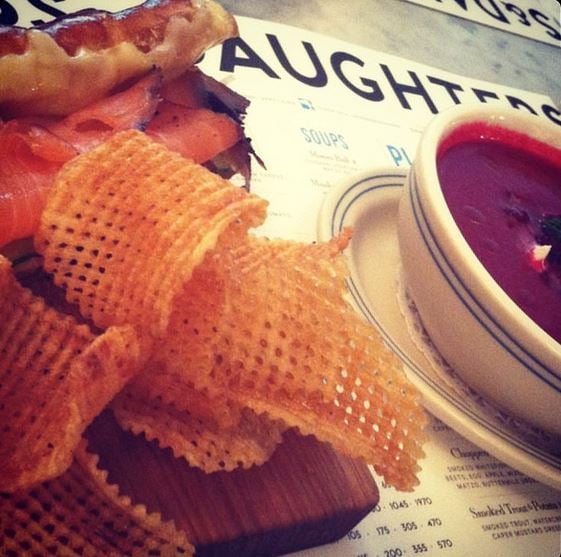
The most recent development in the legacy of Russ and Daughters is a delicious and lovely, sit-down cafe.
The commission had plenty of complaints but found that “there is no special danger to the community from the food supplies sold from pushcarts, for the wares are usually as good, if not better, than the supplies sold in neighboring stores.” In fact, some of the food sold by pushcart vendors was so delicious that their food is still being sold today. For example, Russ & Daughters, a celebrated Lower East Side staple which is celebrating its 100th anniversary this year, which began as a humble pushcart, and is now a renowned purveyor of appetizers most famously smoked salmon. Another pushcart alumnus is Moscot an optical shop that now resides directly across the street from the Tenement Museum. Moscot, much like Russ & Daughters began with the arrival of the patriarch. Shortly after Hyman Moscot emigrated in 1899 from Eastern Europe he began selling eye wear from a pushcart and business has been thriving ever since. Both carts earned loyalty and then financial stability from their delighted customers and have held brick and mortar shops in the neighborhood for nearly a century. Now that’s the American dream. Mazal tov!
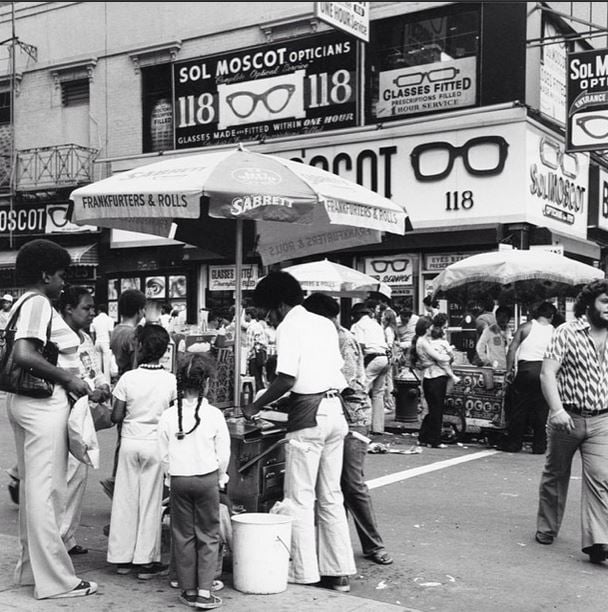
Moscot's storefront appears all over our Lower East Side archival photographs. This picture is from the mid 1970's featuring a new incarnation of pushcart in the foreground.
Eventually the Commission’s regulations attempted to group the pushcarts to less disruptive spots, such as down under the Manhattan bridge and whether because of these measures or for other reasons the pushcart industry eventually dissolved. But don’t worry you can still grab a nosh at Russ & Daughters !
–Posted by Julia Berick
